MGMT861 Reflection: Leadership, Cohesion, Social Loafing Analysis
VerifiedAdded on 2022/11/28
|10
|2412
|179
Report
AI Summary
This reflection report analyzes the dynamics of teamwork, focusing on leadership styles, social loafing, and team cohesion. The student explores the impact of transformational leadership, the concept of social loafing, and the importance of team cohesion on overall performance. The report integrates personal experiences with academic theories, referencing peer-reviewed journal articles to support its analysis. It examines how leadership influences workplace culture, how social loafing affects task allocation, and how team cohesiveness impacts productivity and adaptability. The student discusses the benefits of effective communication, the distribution of tasks, and the role of trust and reliability in fostering a collaborative environment. The report concludes by emphasizing the importance of suitable leadership, cohesiveness, and strategies to mitigate social loafing for achieving common team goals. The student draws on the work of various researchers to support their claims. The student also follows the APA 6th edition for referencing.
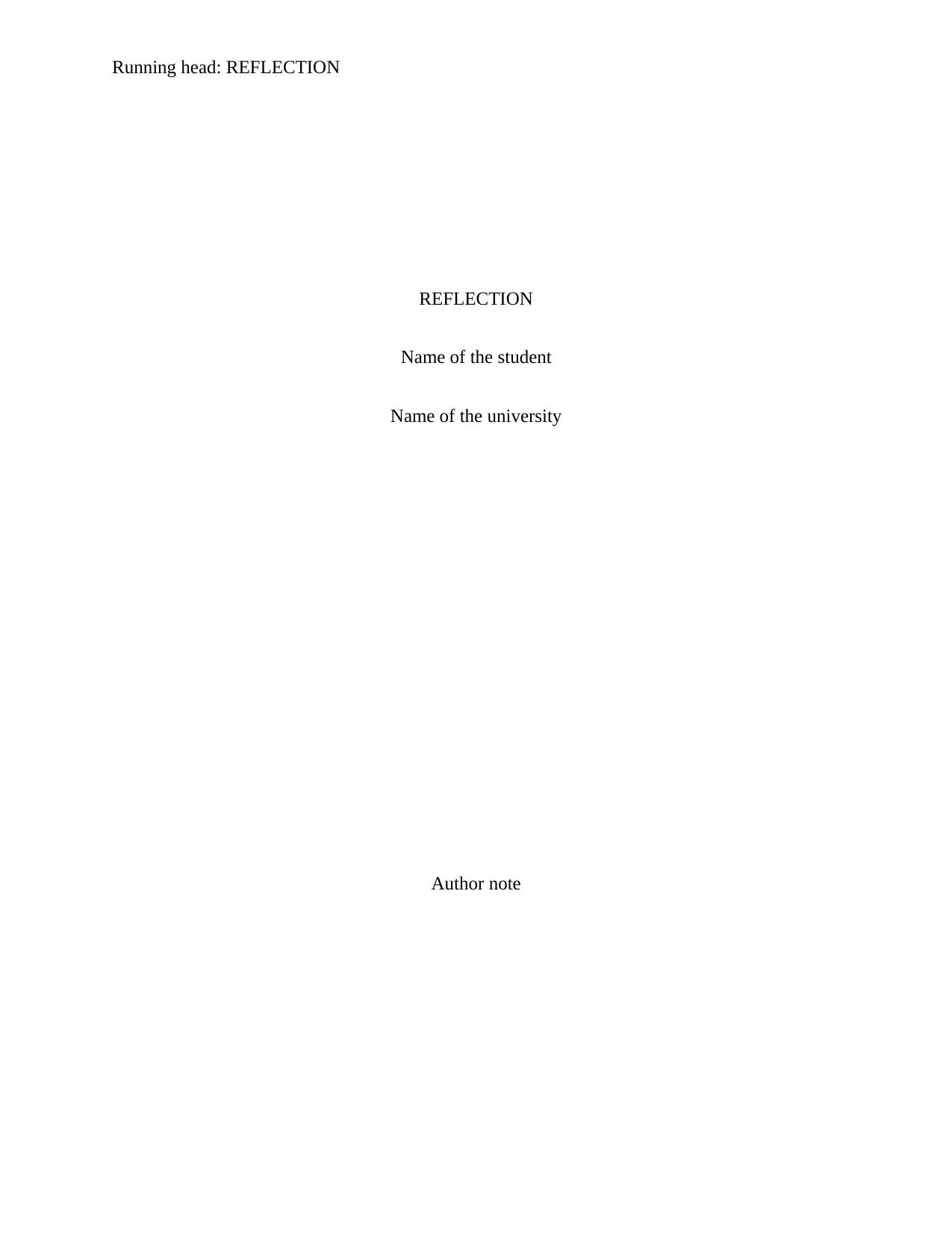
Running head: REFLECTION
REFLECTION
Name of the student
Name of the university
Author note
REFLECTION
Name of the student
Name of the university
Author note
Paraphrase This Document
Need a fresh take? Get an instant paraphrase of this document with our AI Paraphraser
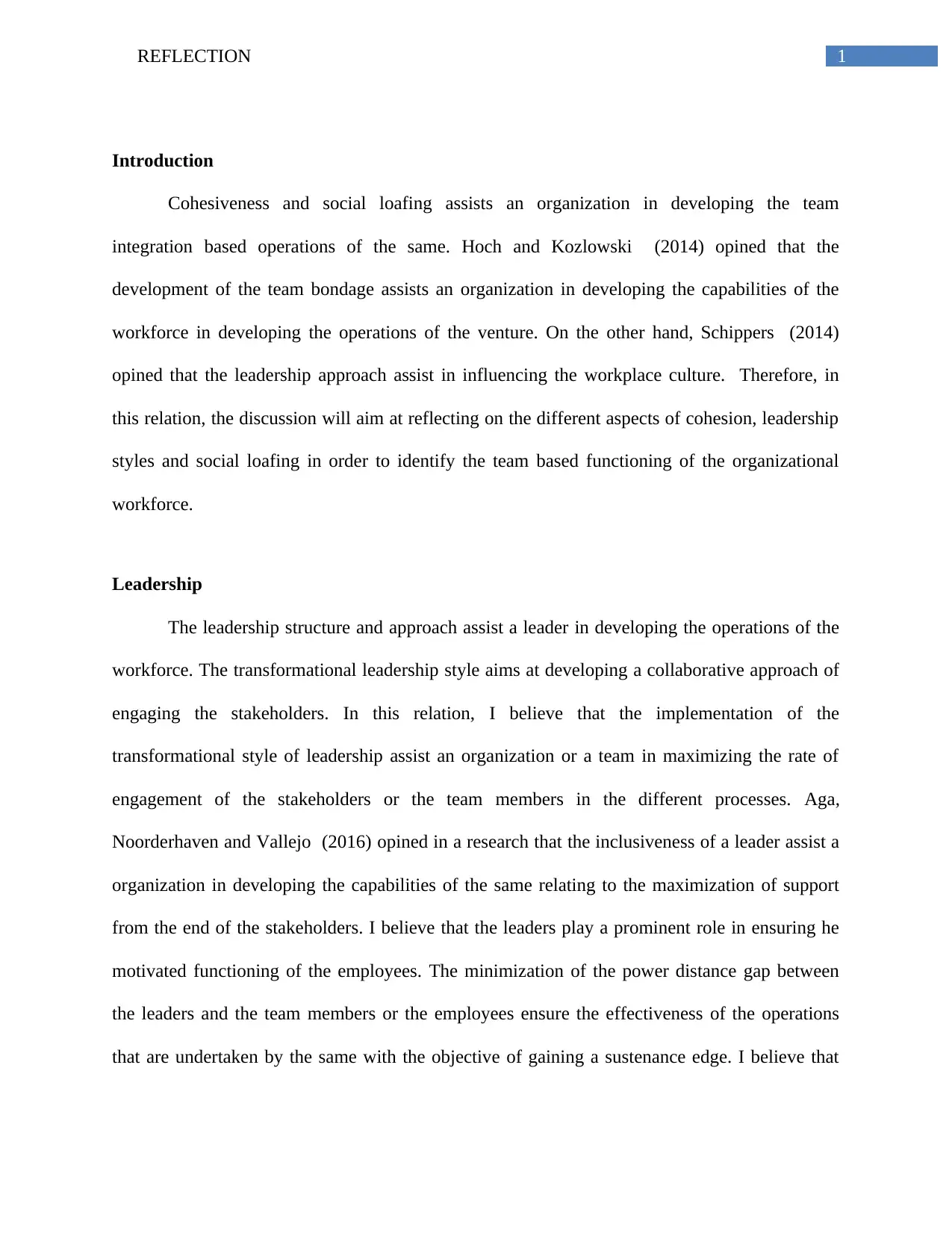
1REFLECTION
Introduction
Cohesiveness and social loafing assists an organization in developing the team
integration based operations of the same. Hoch and Kozlowski (2014) opined that the
development of the team bondage assists an organization in developing the capabilities of the
workforce in developing the operations of the venture. On the other hand, Schippers (2014)
opined that the leadership approach assist in influencing the workplace culture. Therefore, in
this relation, the discussion will aim at reflecting on the different aspects of cohesion, leadership
styles and social loafing in order to identify the team based functioning of the organizational
workforce.
Leadership
The leadership structure and approach assist a leader in developing the operations of the
workforce. The transformational leadership style aims at developing a collaborative approach of
engaging the stakeholders. In this relation, I believe that the implementation of the
transformational style of leadership assist an organization or a team in maximizing the rate of
engagement of the stakeholders or the team members in the different processes. Aga,
Noorderhaven and Vallejo (2016) opined in a research that the inclusiveness of a leader assist a
organization in developing the capabilities of the same relating to the maximization of support
from the end of the stakeholders. I believe that the leaders play a prominent role in ensuring he
motivated functioning of the employees. The minimization of the power distance gap between
the leaders and the team members or the employees ensure the effectiveness of the operations
that are undertaken by the same with the objective of gaining a sustenance edge. I believe that
Introduction
Cohesiveness and social loafing assists an organization in developing the team
integration based operations of the same. Hoch and Kozlowski (2014) opined that the
development of the team bondage assists an organization in developing the capabilities of the
workforce in developing the operations of the venture. On the other hand, Schippers (2014)
opined that the leadership approach assist in influencing the workplace culture. Therefore, in
this relation, the discussion will aim at reflecting on the different aspects of cohesion, leadership
styles and social loafing in order to identify the team based functioning of the organizational
workforce.
Leadership
The leadership structure and approach assist a leader in developing the operations of the
workforce. The transformational leadership style aims at developing a collaborative approach of
engaging the stakeholders. In this relation, I believe that the implementation of the
transformational style of leadership assist an organization or a team in maximizing the rate of
engagement of the stakeholders or the team members in the different processes. Aga,
Noorderhaven and Vallejo (2016) opined in a research that the inclusiveness of a leader assist a
organization in developing the capabilities of the same relating to the maximization of support
from the end of the stakeholders. I believe that the leaders play a prominent role in ensuring he
motivated functioning of the employees. The minimization of the power distance gap between
the leaders and the team members or the employees ensure the effectiveness of the operations
that are undertaken by the same with the objective of gaining a sustenance edge. I believe that
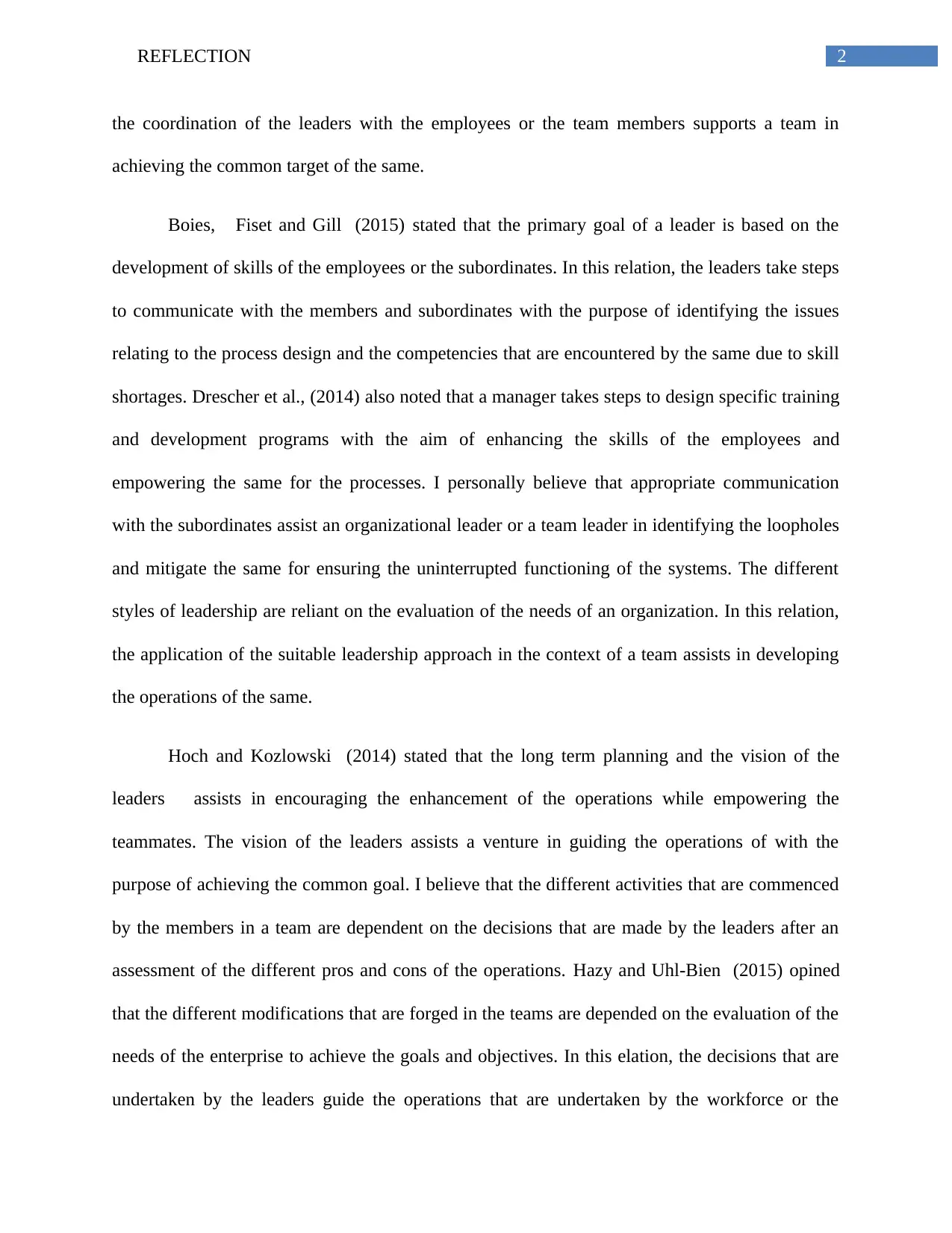
2REFLECTION
the coordination of the leaders with the employees or the team members supports a team in
achieving the common target of the same.
Boies, Fiset and Gill (2015) stated that the primary goal of a leader is based on the
development of skills of the employees or the subordinates. In this relation, the leaders take steps
to communicate with the members and subordinates with the purpose of identifying the issues
relating to the process design and the competencies that are encountered by the same due to skill
shortages. Drescher et al., (2014) also noted that a manager takes steps to design specific training
and development programs with the aim of enhancing the skills of the employees and
empowering the same for the processes. I personally believe that appropriate communication
with the subordinates assist an organizational leader or a team leader in identifying the loopholes
and mitigate the same for ensuring the uninterrupted functioning of the systems. The different
styles of leadership are reliant on the evaluation of the needs of an organization. In this relation,
the application of the suitable leadership approach in the context of a team assists in developing
the operations of the same.
Hoch and Kozlowski (2014) stated that the long term planning and the vision of the
leaders assists in encouraging the enhancement of the operations while empowering the
teammates. The vision of the leaders assists a venture in guiding the operations of with the
purpose of achieving the common goal. I believe that the different activities that are commenced
by the members in a team are dependent on the decisions that are made by the leaders after an
assessment of the different pros and cons of the operations. Hazy and Uhl-Bien (2015) opined
that the different modifications that are forged in the teams are depended on the evaluation of the
needs of the enterprise to achieve the goals and objectives. In this elation, the decisions that are
undertaken by the leaders guide the operations that are undertaken by the workforce or the
the coordination of the leaders with the employees or the team members supports a team in
achieving the common target of the same.
Boies, Fiset and Gill (2015) stated that the primary goal of a leader is based on the
development of skills of the employees or the subordinates. In this relation, the leaders take steps
to communicate with the members and subordinates with the purpose of identifying the issues
relating to the process design and the competencies that are encountered by the same due to skill
shortages. Drescher et al., (2014) also noted that a manager takes steps to design specific training
and development programs with the aim of enhancing the skills of the employees and
empowering the same for the processes. I personally believe that appropriate communication
with the subordinates assist an organizational leader or a team leader in identifying the loopholes
and mitigate the same for ensuring the uninterrupted functioning of the systems. The different
styles of leadership are reliant on the evaluation of the needs of an organization. In this relation,
the application of the suitable leadership approach in the context of a team assists in developing
the operations of the same.
Hoch and Kozlowski (2014) stated that the long term planning and the vision of the
leaders assists in encouraging the enhancement of the operations while empowering the
teammates. The vision of the leaders assists a venture in guiding the operations of with the
purpose of achieving the common goal. I believe that the different activities that are commenced
by the members in a team are dependent on the decisions that are made by the leaders after an
assessment of the different pros and cons of the operations. Hazy and Uhl-Bien (2015) opined
that the different modifications that are forged in the teams are depended on the evaluation of the
needs of the enterprise to achieve the goals and objectives. In this elation, the decisions that are
undertaken by the leaders guide the operations that are undertaken by the workforce or the
⊘ This is a preview!⊘
Do you want full access?
Subscribe today to unlock all pages.

Trusted by 1+ million students worldwide
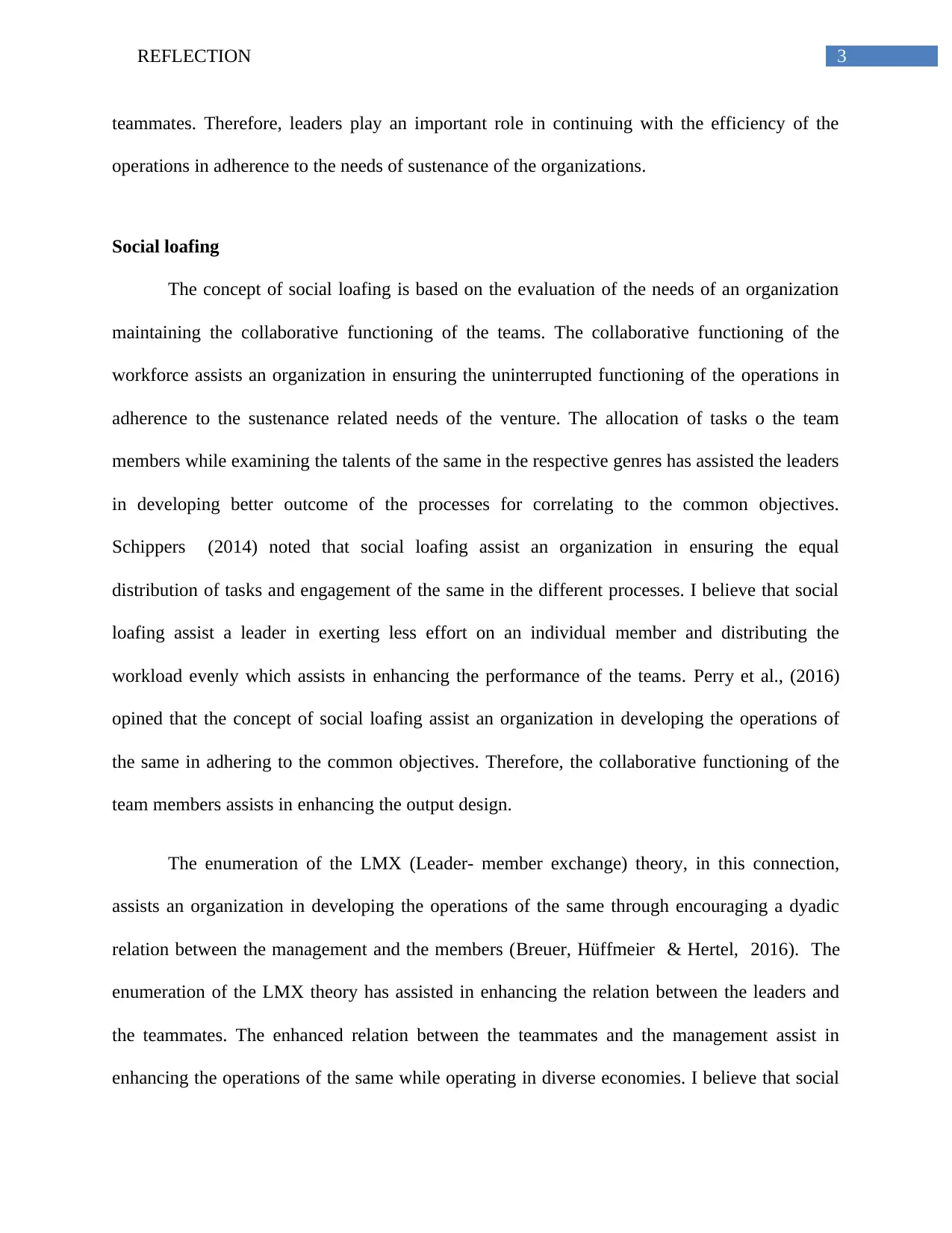
3REFLECTION
teammates. Therefore, leaders play an important role in continuing with the efficiency of the
operations in adherence to the needs of sustenance of the organizations.
Social loafing
The concept of social loafing is based on the evaluation of the needs of an organization
maintaining the collaborative functioning of the teams. The collaborative functioning of the
workforce assists an organization in ensuring the uninterrupted functioning of the operations in
adherence to the sustenance related needs of the venture. The allocation of tasks o the team
members while examining the talents of the same in the respective genres has assisted the leaders
in developing better outcome of the processes for correlating to the common objectives.
Schippers (2014) noted that social loafing assist an organization in ensuring the equal
distribution of tasks and engagement of the same in the different processes. I believe that social
loafing assist a leader in exerting less effort on an individual member and distributing the
workload evenly which assists in enhancing the performance of the teams. Perry et al., (2016)
opined that the concept of social loafing assist an organization in developing the operations of
the same in adhering to the common objectives. Therefore, the collaborative functioning of the
team members assists in enhancing the output design.
The enumeration of the LMX (Leader- member exchange) theory, in this connection,
assists an organization in developing the operations of the same through encouraging a dyadic
relation between the management and the members (Breuer, Hüffmeier & Hertel, 2016). The
enumeration of the LMX theory has assisted in enhancing the relation between the leaders and
the teammates. The enhanced relation between the teammates and the management assist in
enhancing the operations of the same while operating in diverse economies. I believe that social
teammates. Therefore, leaders play an important role in continuing with the efficiency of the
operations in adherence to the needs of sustenance of the organizations.
Social loafing
The concept of social loafing is based on the evaluation of the needs of an organization
maintaining the collaborative functioning of the teams. The collaborative functioning of the
workforce assists an organization in ensuring the uninterrupted functioning of the operations in
adherence to the sustenance related needs of the venture. The allocation of tasks o the team
members while examining the talents of the same in the respective genres has assisted the leaders
in developing better outcome of the processes for correlating to the common objectives.
Schippers (2014) noted that social loafing assist an organization in ensuring the equal
distribution of tasks and engagement of the same in the different processes. I believe that social
loafing assist a leader in exerting less effort on an individual member and distributing the
workload evenly which assists in enhancing the performance of the teams. Perry et al., (2016)
opined that the concept of social loafing assist an organization in developing the operations of
the same in adhering to the common objectives. Therefore, the collaborative functioning of the
team members assists in enhancing the output design.
The enumeration of the LMX (Leader- member exchange) theory, in this connection,
assists an organization in developing the operations of the same through encouraging a dyadic
relation between the management and the members (Breuer, Hüffmeier & Hertel, 2016). The
enumeration of the LMX theory has assisted in enhancing the relation between the leaders and
the teammates. The enhanced relation between the teammates and the management assist in
enhancing the operations of the same while operating in diverse economies. I believe that social
Paraphrase This Document
Need a fresh take? Get an instant paraphrase of this document with our AI Paraphraser
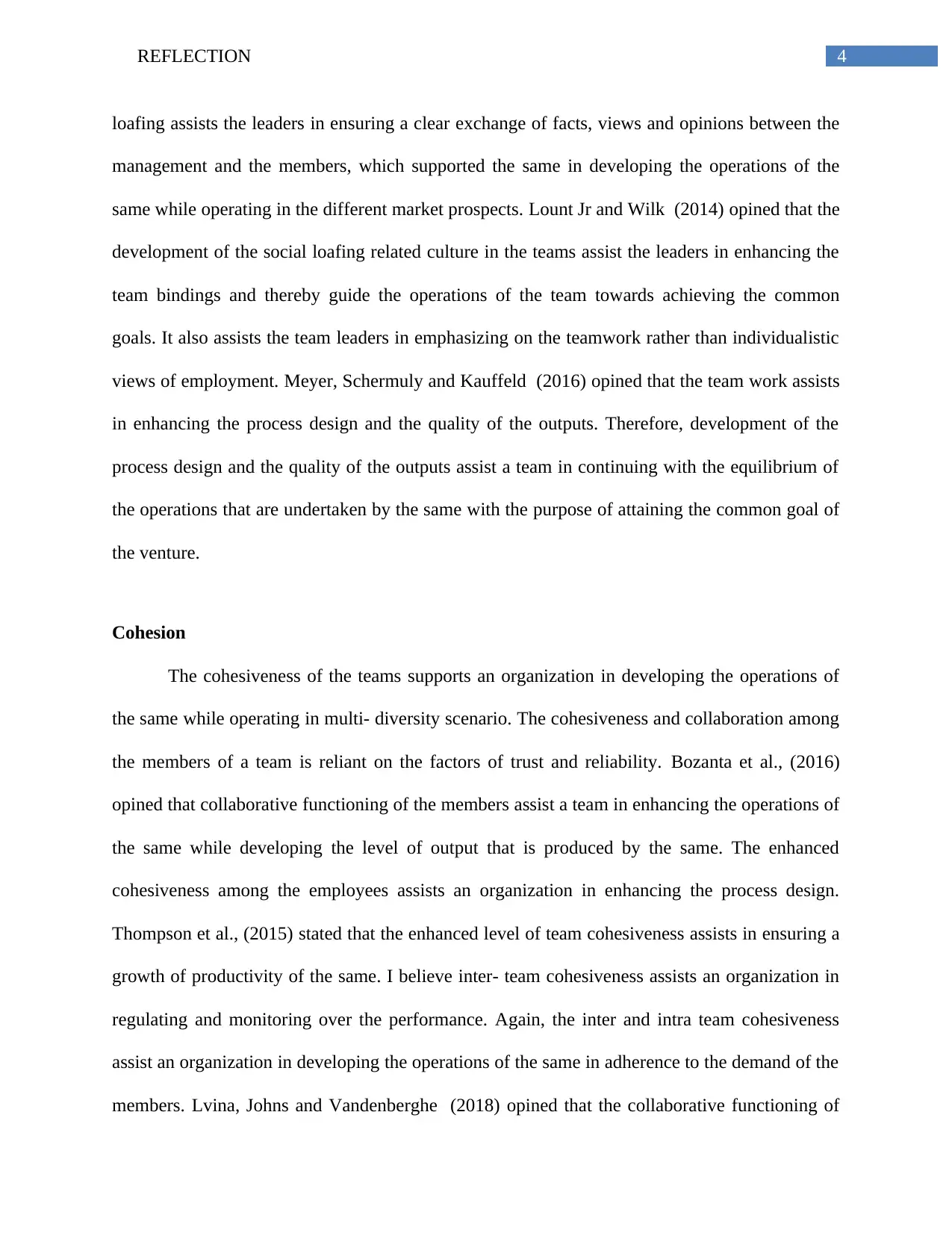
4REFLECTION
loafing assists the leaders in ensuring a clear exchange of facts, views and opinions between the
management and the members, which supported the same in developing the operations of the
same while operating in the different market prospects. Lount Jr and Wilk (2014) opined that the
development of the social loafing related culture in the teams assist the leaders in enhancing the
team bindings and thereby guide the operations of the team towards achieving the common
goals. It also assists the team leaders in emphasizing on the teamwork rather than individualistic
views of employment. Meyer, Schermuly and Kauffeld (2016) opined that the team work assists
in enhancing the process design and the quality of the outputs. Therefore, development of the
process design and the quality of the outputs assist a team in continuing with the equilibrium of
the operations that are undertaken by the same with the purpose of attaining the common goal of
the venture.
Cohesion
The cohesiveness of the teams supports an organization in developing the operations of
the same while operating in multi- diversity scenario. The cohesiveness and collaboration among
the members of a team is reliant on the factors of trust and reliability. Bozanta et al., (2016)
opined that collaborative functioning of the members assist a team in enhancing the operations of
the same while developing the level of output that is produced by the same. The enhanced
cohesiveness among the employees assists an organization in enhancing the process design.
Thompson et al., (2015) stated that the enhanced level of team cohesiveness assists in ensuring a
growth of productivity of the same. I believe inter- team cohesiveness assists an organization in
regulating and monitoring over the performance. Again, the inter and intra team cohesiveness
assist an organization in developing the operations of the same in adherence to the demand of the
members. Lvina, Johns and Vandenberghe (2018) opined that the collaborative functioning of
loafing assists the leaders in ensuring a clear exchange of facts, views and opinions between the
management and the members, which supported the same in developing the operations of the
same while operating in the different market prospects. Lount Jr and Wilk (2014) opined that the
development of the social loafing related culture in the teams assist the leaders in enhancing the
team bindings and thereby guide the operations of the team towards achieving the common
goals. It also assists the team leaders in emphasizing on the teamwork rather than individualistic
views of employment. Meyer, Schermuly and Kauffeld (2016) opined that the team work assists
in enhancing the process design and the quality of the outputs. Therefore, development of the
process design and the quality of the outputs assist a team in continuing with the equilibrium of
the operations that are undertaken by the same with the purpose of attaining the common goal of
the venture.
Cohesion
The cohesiveness of the teams supports an organization in developing the operations of
the same while operating in multi- diversity scenario. The cohesiveness and collaboration among
the members of a team is reliant on the factors of trust and reliability. Bozanta et al., (2016)
opined that collaborative functioning of the members assist a team in enhancing the operations of
the same while developing the level of output that is produced by the same. The enhanced
cohesiveness among the employees assists an organization in enhancing the process design.
Thompson et al., (2015) stated that the enhanced level of team cohesiveness assists in ensuring a
growth of productivity of the same. I believe inter- team cohesiveness assists an organization in
regulating and monitoring over the performance. Again, the inter and intra team cohesiveness
assist an organization in developing the operations of the same in adherence to the demand of the
members. Lvina, Johns and Vandenberghe (2018) opined that the collaborative functioning of
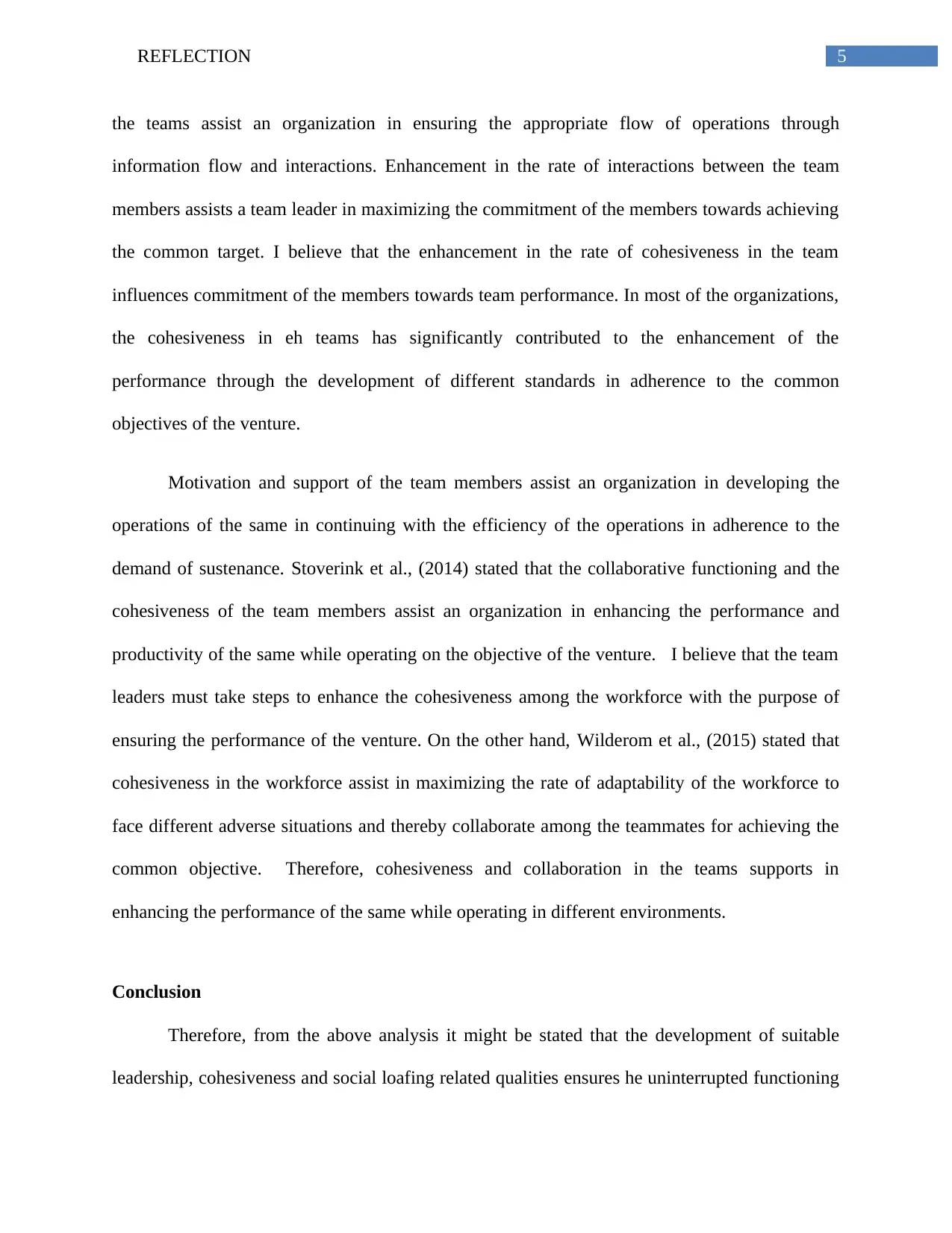
5REFLECTION
the teams assist an organization in ensuring the appropriate flow of operations through
information flow and interactions. Enhancement in the rate of interactions between the team
members assists a team leader in maximizing the commitment of the members towards achieving
the common target. I believe that the enhancement in the rate of cohesiveness in the team
influences commitment of the members towards team performance. In most of the organizations,
the cohesiveness in eh teams has significantly contributed to the enhancement of the
performance through the development of different standards in adherence to the common
objectives of the venture.
Motivation and support of the team members assist an organization in developing the
operations of the same in continuing with the efficiency of the operations in adherence to the
demand of sustenance. Stoverink et al., (2014) stated that the collaborative functioning and the
cohesiveness of the team members assist an organization in enhancing the performance and
productivity of the same while operating on the objective of the venture. I believe that the team
leaders must take steps to enhance the cohesiveness among the workforce with the purpose of
ensuring the performance of the venture. On the other hand, Wilderom et al., (2015) stated that
cohesiveness in the workforce assist in maximizing the rate of adaptability of the workforce to
face different adverse situations and thereby collaborate among the teammates for achieving the
common objective. Therefore, cohesiveness and collaboration in the teams supports in
enhancing the performance of the same while operating in different environments.
Conclusion
Therefore, from the above analysis it might be stated that the development of suitable
leadership, cohesiveness and social loafing related qualities ensures he uninterrupted functioning
the teams assist an organization in ensuring the appropriate flow of operations through
information flow and interactions. Enhancement in the rate of interactions between the team
members assists a team leader in maximizing the commitment of the members towards achieving
the common target. I believe that the enhancement in the rate of cohesiveness in the team
influences commitment of the members towards team performance. In most of the organizations,
the cohesiveness in eh teams has significantly contributed to the enhancement of the
performance through the development of different standards in adherence to the common
objectives of the venture.
Motivation and support of the team members assist an organization in developing the
operations of the same in continuing with the efficiency of the operations in adherence to the
demand of sustenance. Stoverink et al., (2014) stated that the collaborative functioning and the
cohesiveness of the team members assist an organization in enhancing the performance and
productivity of the same while operating on the objective of the venture. I believe that the team
leaders must take steps to enhance the cohesiveness among the workforce with the purpose of
ensuring the performance of the venture. On the other hand, Wilderom et al., (2015) stated that
cohesiveness in the workforce assist in maximizing the rate of adaptability of the workforce to
face different adverse situations and thereby collaborate among the teammates for achieving the
common objective. Therefore, cohesiveness and collaboration in the teams supports in
enhancing the performance of the same while operating in different environments.
Conclusion
Therefore, from the above analysis it might be stated that the development of suitable
leadership, cohesiveness and social loafing related qualities ensures he uninterrupted functioning
⊘ This is a preview!⊘
Do you want full access?
Subscribe today to unlock all pages.

Trusted by 1+ million students worldwide
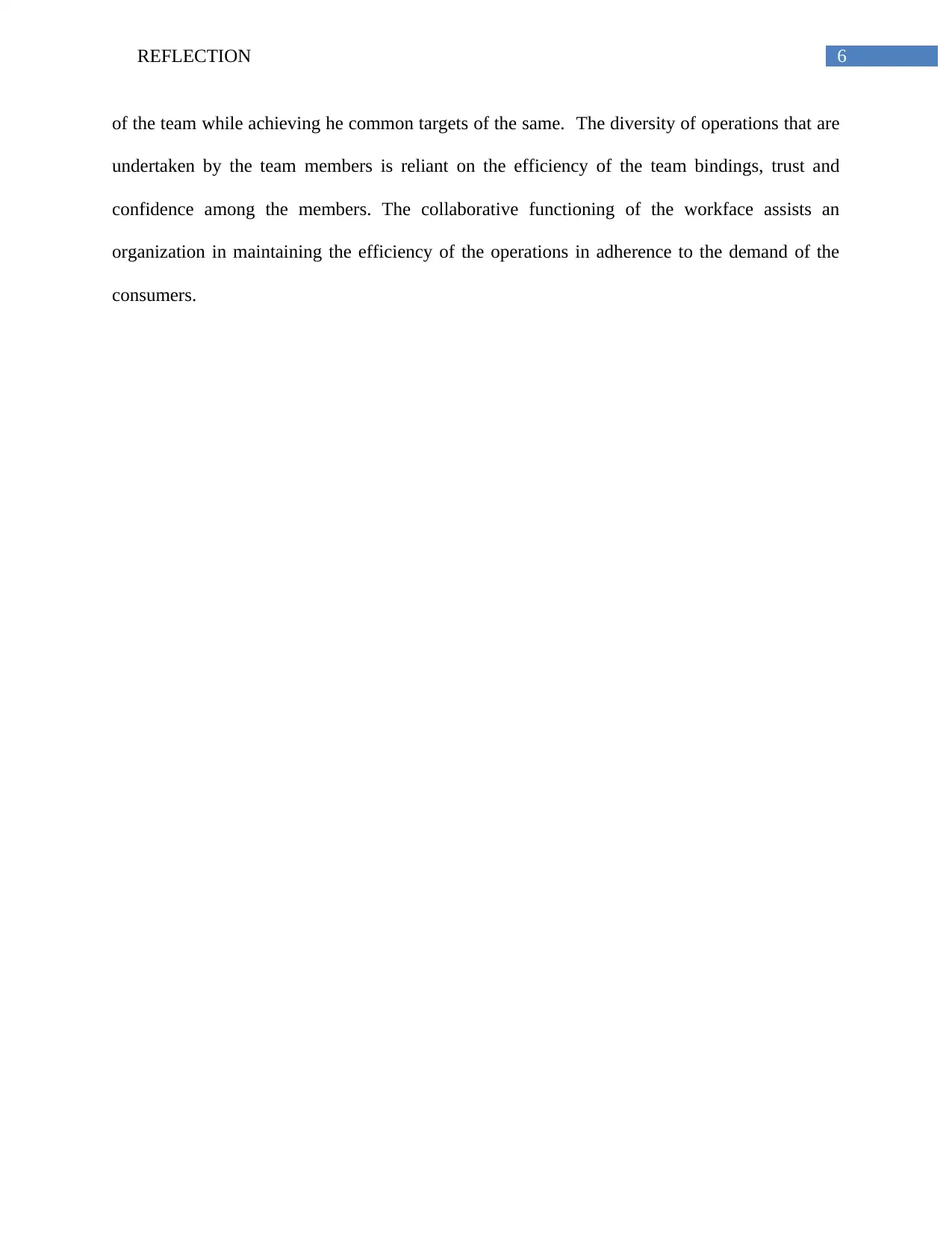
6REFLECTION
of the team while achieving he common targets of the same. The diversity of operations that are
undertaken by the team members is reliant on the efficiency of the team bindings, trust and
confidence among the members. The collaborative functioning of the workface assists an
organization in maintaining the efficiency of the operations in adherence to the demand of the
consumers.
of the team while achieving he common targets of the same. The diversity of operations that are
undertaken by the team members is reliant on the efficiency of the team bindings, trust and
confidence among the members. The collaborative functioning of the workface assists an
organization in maintaining the efficiency of the operations in adherence to the demand of the
consumers.
Paraphrase This Document
Need a fresh take? Get an instant paraphrase of this document with our AI Paraphraser
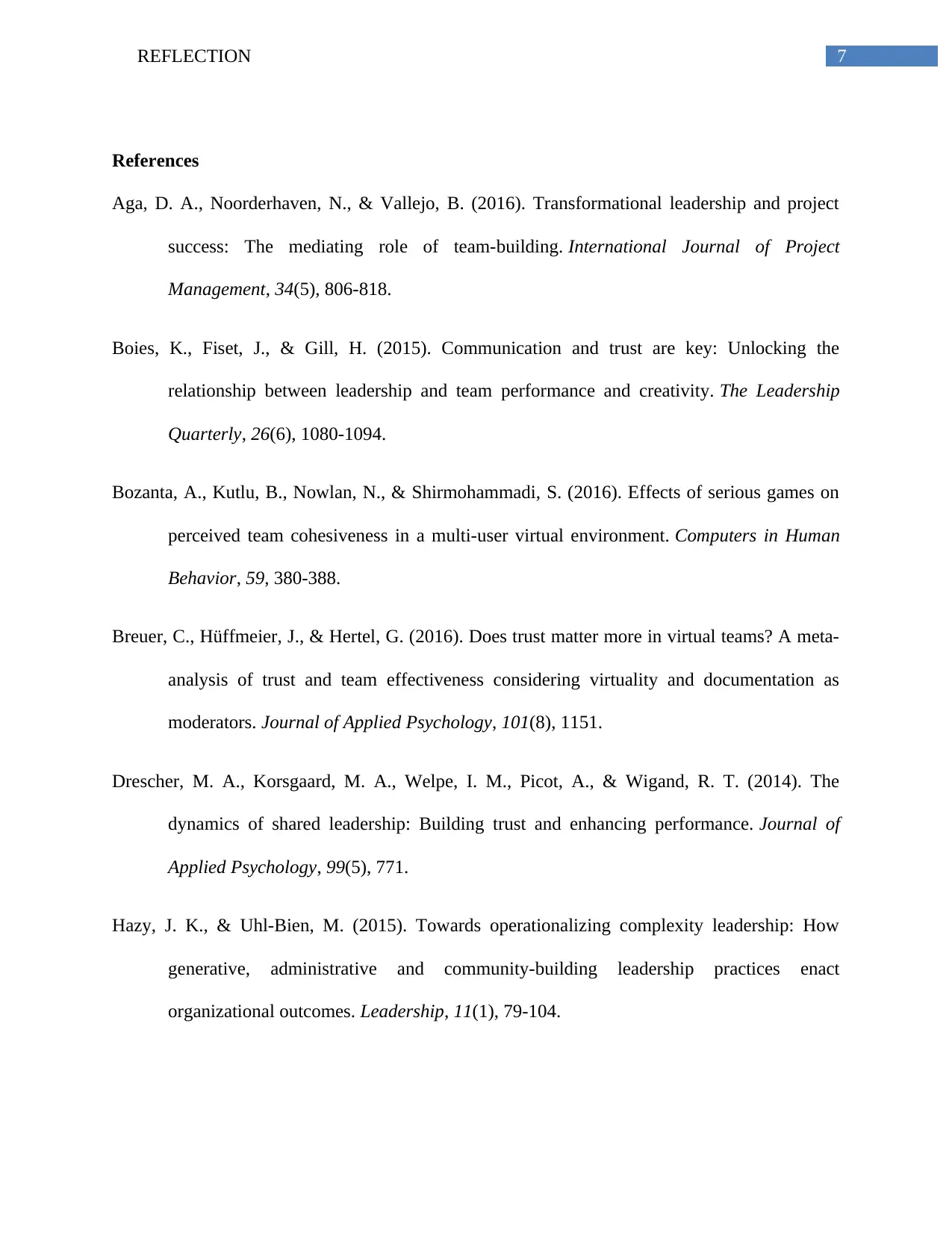
7REFLECTION
References
Aga, D. A., Noorderhaven, N., & Vallejo, B. (2016). Transformational leadership and project
success: The mediating role of team-building. International Journal of Project
Management, 34(5), 806-818.
Boies, K., Fiset, J., & Gill, H. (2015). Communication and trust are key: Unlocking the
relationship between leadership and team performance and creativity. The Leadership
Quarterly, 26(6), 1080-1094.
Bozanta, A., Kutlu, B., Nowlan, N., & Shirmohammadi, S. (2016). Effects of serious games on
perceived team cohesiveness in a multi-user virtual environment. Computers in Human
Behavior, 59, 380-388.
Breuer, C., Hüffmeier, J., & Hertel, G. (2016). Does trust matter more in virtual teams? A meta-
analysis of trust and team effectiveness considering virtuality and documentation as
moderators. Journal of Applied Psychology, 101(8), 1151.
Drescher, M. A., Korsgaard, M. A., Welpe, I. M., Picot, A., & Wigand, R. T. (2014). The
dynamics of shared leadership: Building trust and enhancing performance. Journal of
Applied Psychology, 99(5), 771.
Hazy, J. K., & Uhl-Bien, M. (2015). Towards operationalizing complexity leadership: How
generative, administrative and community-building leadership practices enact
organizational outcomes. Leadership, 11(1), 79-104.
References
Aga, D. A., Noorderhaven, N., & Vallejo, B. (2016). Transformational leadership and project
success: The mediating role of team-building. International Journal of Project
Management, 34(5), 806-818.
Boies, K., Fiset, J., & Gill, H. (2015). Communication and trust are key: Unlocking the
relationship between leadership and team performance and creativity. The Leadership
Quarterly, 26(6), 1080-1094.
Bozanta, A., Kutlu, B., Nowlan, N., & Shirmohammadi, S. (2016). Effects of serious games on
perceived team cohesiveness in a multi-user virtual environment. Computers in Human
Behavior, 59, 380-388.
Breuer, C., Hüffmeier, J., & Hertel, G. (2016). Does trust matter more in virtual teams? A meta-
analysis of trust and team effectiveness considering virtuality and documentation as
moderators. Journal of Applied Psychology, 101(8), 1151.
Drescher, M. A., Korsgaard, M. A., Welpe, I. M., Picot, A., & Wigand, R. T. (2014). The
dynamics of shared leadership: Building trust and enhancing performance. Journal of
Applied Psychology, 99(5), 771.
Hazy, J. K., & Uhl-Bien, M. (2015). Towards operationalizing complexity leadership: How
generative, administrative and community-building leadership practices enact
organizational outcomes. Leadership, 11(1), 79-104.
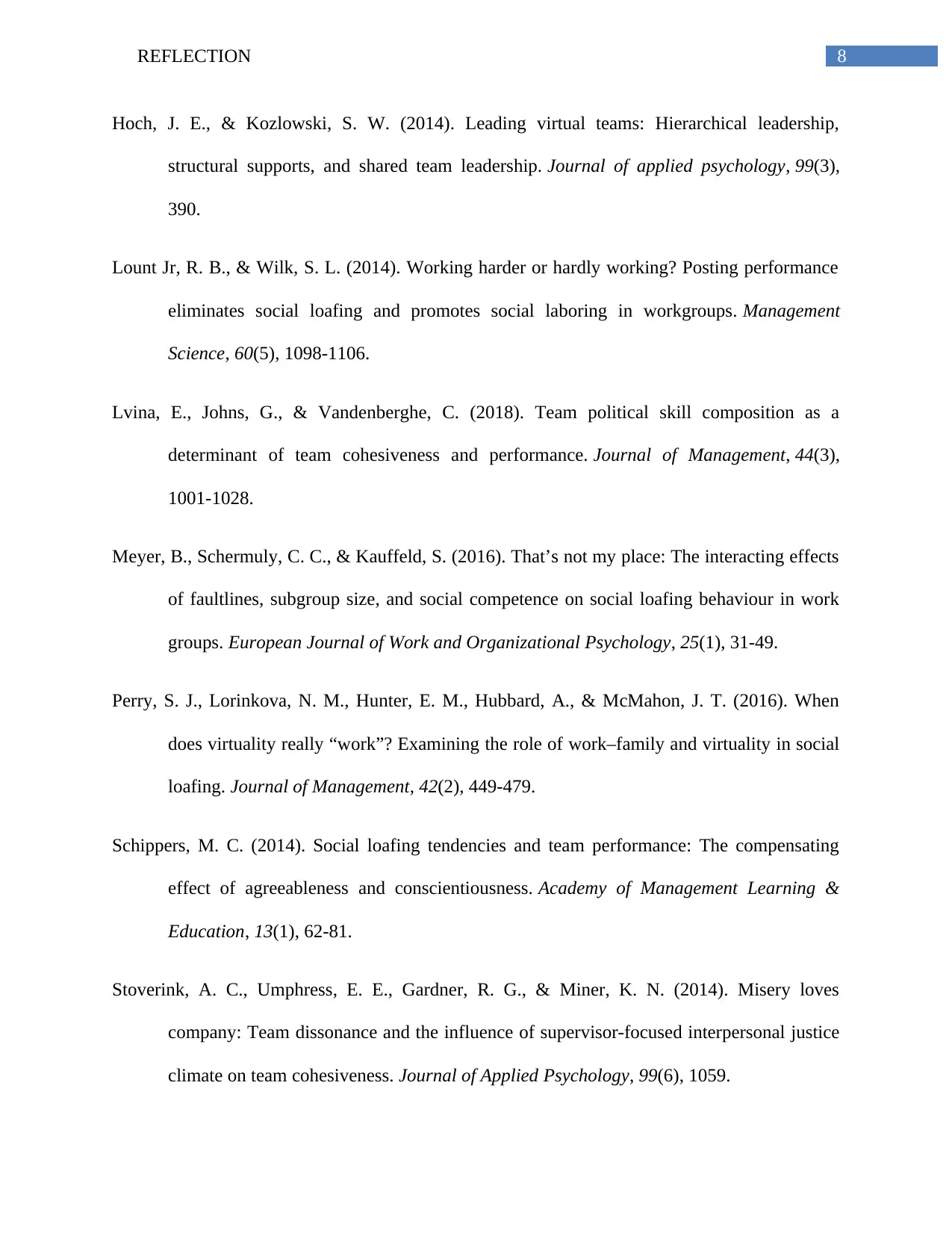
8REFLECTION
Hoch, J. E., & Kozlowski, S. W. (2014). Leading virtual teams: Hierarchical leadership,
structural supports, and shared team leadership. Journal of applied psychology, 99(3),
390.
Lount Jr, R. B., & Wilk, S. L. (2014). Working harder or hardly working? Posting performance
eliminates social loafing and promotes social laboring in workgroups. Management
Science, 60(5), 1098-1106.
Lvina, E., Johns, G., & Vandenberghe, C. (2018). Team political skill composition as a
determinant of team cohesiveness and performance. Journal of Management, 44(3),
1001-1028.
Meyer, B., Schermuly, C. C., & Kauffeld, S. (2016). That’s not my place: The interacting effects
of faultlines, subgroup size, and social competence on social loafing behaviour in work
groups. European Journal of Work and Organizational Psychology, 25(1), 31-49.
Perry, S. J., Lorinkova, N. M., Hunter, E. M., Hubbard, A., & McMahon, J. T. (2016). When
does virtuality really “work”? Examining the role of work–family and virtuality in social
loafing. Journal of Management, 42(2), 449-479.
Schippers, M. C. (2014). Social loafing tendencies and team performance: The compensating
effect of agreeableness and conscientiousness. Academy of Management Learning &
Education, 13(1), 62-81.
Stoverink, A. C., Umphress, E. E., Gardner, R. G., & Miner, K. N. (2014). Misery loves
company: Team dissonance and the influence of supervisor-focused interpersonal justice
climate on team cohesiveness. Journal of Applied Psychology, 99(6), 1059.
Hoch, J. E., & Kozlowski, S. W. (2014). Leading virtual teams: Hierarchical leadership,
structural supports, and shared team leadership. Journal of applied psychology, 99(3),
390.
Lount Jr, R. B., & Wilk, S. L. (2014). Working harder or hardly working? Posting performance
eliminates social loafing and promotes social laboring in workgroups. Management
Science, 60(5), 1098-1106.
Lvina, E., Johns, G., & Vandenberghe, C. (2018). Team political skill composition as a
determinant of team cohesiveness and performance. Journal of Management, 44(3),
1001-1028.
Meyer, B., Schermuly, C. C., & Kauffeld, S. (2016). That’s not my place: The interacting effects
of faultlines, subgroup size, and social competence on social loafing behaviour in work
groups. European Journal of Work and Organizational Psychology, 25(1), 31-49.
Perry, S. J., Lorinkova, N. M., Hunter, E. M., Hubbard, A., & McMahon, J. T. (2016). When
does virtuality really “work”? Examining the role of work–family and virtuality in social
loafing. Journal of Management, 42(2), 449-479.
Schippers, M. C. (2014). Social loafing tendencies and team performance: The compensating
effect of agreeableness and conscientiousness. Academy of Management Learning &
Education, 13(1), 62-81.
Stoverink, A. C., Umphress, E. E., Gardner, R. G., & Miner, K. N. (2014). Misery loves
company: Team dissonance and the influence of supervisor-focused interpersonal justice
climate on team cohesiveness. Journal of Applied Psychology, 99(6), 1059.
⊘ This is a preview!⊘
Do you want full access?
Subscribe today to unlock all pages.

Trusted by 1+ million students worldwide
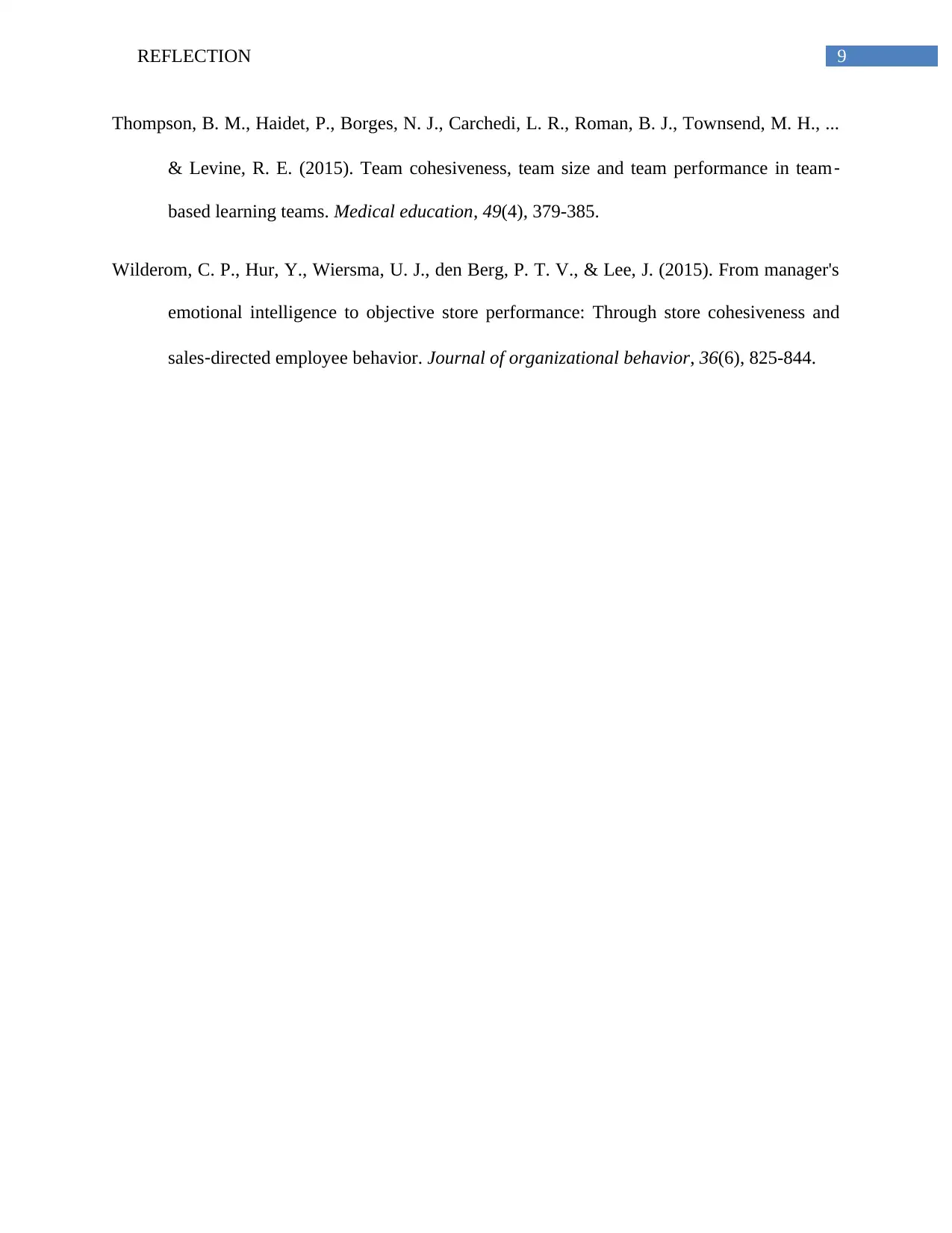
9REFLECTION
Thompson, B. M., Haidet, P., Borges, N. J., Carchedi, L. R., Roman, B. J., Townsend, M. H., ...
& Levine, R. E. (2015). Team cohesiveness, team size and team performance in team‐
based learning teams. Medical education, 49(4), 379-385.
Wilderom, C. P., Hur, Y., Wiersma, U. J., den Berg, P. T. V., & Lee, J. (2015). From manager's
emotional intelligence to objective store performance: Through store cohesiveness and
sales‐directed employee behavior. Journal of organizational behavior, 36(6), 825-844.
Thompson, B. M., Haidet, P., Borges, N. J., Carchedi, L. R., Roman, B. J., Townsend, M. H., ...
& Levine, R. E. (2015). Team cohesiveness, team size and team performance in team‐
based learning teams. Medical education, 49(4), 379-385.
Wilderom, C. P., Hur, Y., Wiersma, U. J., den Berg, P. T. V., & Lee, J. (2015). From manager's
emotional intelligence to objective store performance: Through store cohesiveness and
sales‐directed employee behavior. Journal of organizational behavior, 36(6), 825-844.
1 out of 10
Related Documents
Your All-in-One AI-Powered Toolkit for Academic Success.
+13062052269
info@desklib.com
Available 24*7 on WhatsApp / Email
![[object Object]](/_next/static/media/star-bottom.7253800d.svg)
Unlock your academic potential
Copyright © 2020–2025 A2Z Services. All Rights Reserved. Developed and managed by ZUCOL.





